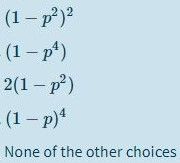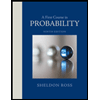
A First Course in Probability (10th Edition)
10th Edition
ISBN: 9780134753119
Author: Sheldon Ross
Publisher: PEARSON
expand_more
expand_more
format_list_bulleted
Topic Video
Question
There are two ways of moving from point X to point Y and two ways of moving from point Y to point Z.
If each way is blockaded with the probabilty p, the
possible options:

Transcribed Image Text:(1 – p')?
- (1– p')
2(1 - р?)
-(1– p)
None of the other choices
Expert Solution
This question has been solved!
Explore an expertly crafted, step-by-step solution for a thorough understanding of key concepts.
Step by stepSolved in 2 steps with 1 images

Knowledge Booster
Learn more about
Need a deep-dive on the concept behind this application? Look no further. Learn more about this topic, probability and related others by exploring similar questions and additional content below.Similar questions
- 7. A student has three routes of getting to his school: A, B, and C. Each day he picks one, and his choice is influenced only by his previous day choice: – if he takes route A today, then he will take route A, B, or C next day with respective 1 1 probabilities, 244 - if he takes route B today, then he will take route A, B, or C next day with respective 1 probabilities, 0, 2 - if he takes route C today, then he will take route A, B, or C next day with respective 1 probabilities 3'4'12' (a) Formulate this as a Markov chain by defining its states and giving its (one-step) transition matrix. (b) Find the n-step transition matrix P(n)=2 and 20. (c) If he takes route A today, what is the probability that he will take route A in 2 the day after tomorrow? (d) The probability that he takes route A today is 0.4. Use the results from part (b) to determine the probability that he will take route B 20 days from now. i=0 (a) Use equations лP = π, Σ²0¹₁ = 1 to find the steady state probabilities. Are…arrow_forwardIf P(A A. B. C. D. B) = 0 A and B are P(A) + P(B) = 1 independent events. A and B are mutually exclusive events. either P(A) = 0 or P(B) = 0.arrow_forwardSuppose there is a 3-stage experiment that are pairwise independent (i.e. they’re all independent from eachother). If stage one has 5 outcomes stage two has 6 outcomes and stage three has 2 possible outcomes, howmany outcomes does the experiment itself have?arrow_forward
arrow_back_ios
arrow_forward_ios
Recommended textbooks for you
 A First Course in Probability (10th Edition)ProbabilityISBN:9780134753119Author:Sheldon RossPublisher:PEARSON
A First Course in Probability (10th Edition)ProbabilityISBN:9780134753119Author:Sheldon RossPublisher:PEARSON

A First Course in Probability (10th Edition)
Probability
ISBN:9780134753119
Author:Sheldon Ross
Publisher:PEARSON
